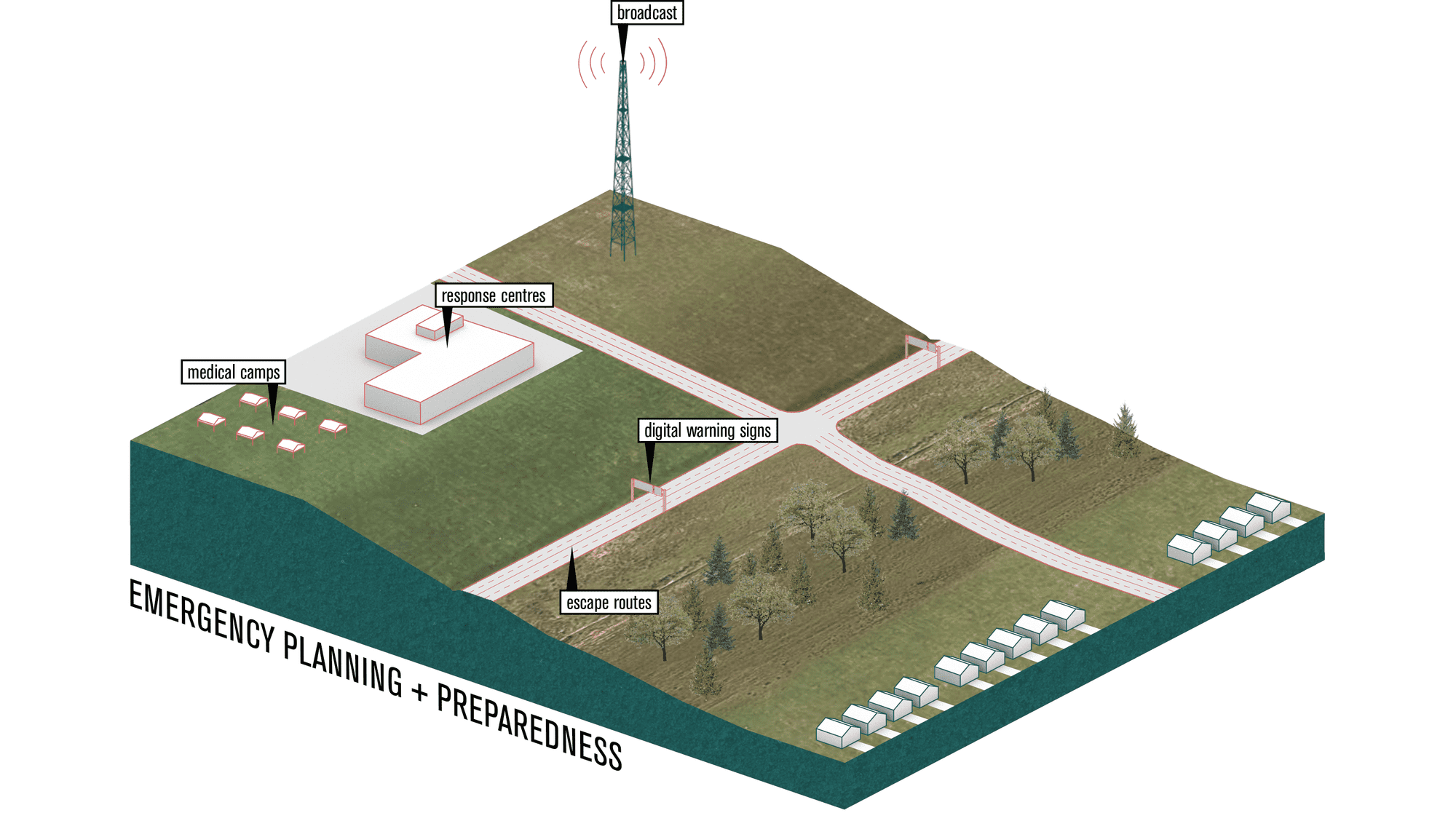Adaptation Strategy: Emergency Planning Preparedness
Emergency planning and preparedness is a coordinated process that involves assessing the likely impacts of a disaster event and coordinating a set of responses to reduce or prevent property damage. Planning approaches such as evacuation routes and plans, emergency management plans, tsunami response plans can be implemented before a disaster to reduce the damage to property, infrastructure, economy, and transportation.1 Preparing for coastal hazards allows local governments to declare a local emergency in the face of a storm surge.2 The effectiveness of emergency plans is determined by the level of commitment and resources allocated and requires regular updates over time.3
How it works
Types of emergency planning preparedness
- Evacuation routes are designated pathways for egress to a place that is safe before or during an emergency event
- Municipal emergency plans govern the provision of important emergency services and the procedures that regulate emergency response. These plans specify the procedures that guide the safe evacuation of persons in the face of an emergency. 14
- Emergency management plans serve to guide the process of disaster response. They are designed to help planning agencies meet or exceed their responsibilities for disaster preparedness 10
- Tsunami response plans are activated when a tsunami warning is received. The plan triggers a sequence of actions in response to a tsunami event. 11
Benefits
- Enables agencies to develop operational reliability based on experience and operational knowledge from past experiences.
- Allows multiple agencies to collaborate during a disaster event. This serves to reduce communication time.
- Enables external system connectivity which allows agencies to interface with external systems such as road networks and cameras to reduce response time.
- Enables post-operation analysis which helps to identify key activities and facilitates the assessment of lessons learned that can inform planning for future disaster events. 12
Challenges
- There might be hidden costs that are not included during the planning process
- The magnitude of an event might exceed the response capacity of existing plans.
- Response processes may require fluid adaptation during an actual event. This could make it difficult to estimate the requirement for personnel support.
- Estimating logistical and administrative support might be difficult because support systems might be overwhelmed by the magnitude of an event. 13
- Effectiveness depends on the level of commitment and resource allocation.
Example projects
BC Flood Emergency Plan
BC, Canada
The British Columbia Flood Emergency Plan outlines the framework for the province to coordinate flood-related activities.7 The roles and responsibilities of provincial ministries, first nations, and local authorities are clarified within the emergency plan. The plan also outlines the concept of operations that fosters collaboration between these groups.8 The Flood Emergency Plan defines emergency management as a ‘continuous process’ consisting of four phases: mitigation, preparedness, response, and recovery.9 Within these phases are general actions that are undertaken by first nation groups, ministries, and local authorities.
Tokyo Rinkai Disaster Prevention Park
Koto City, Japan
In Metropolitan Tokyo, parks have become designated locations and central bases of operations for disaster prevention. The Tokyo Rinkai Disaster Prevention Park is one of the many designated bases of operations that houses emergency response facilities.4 During standard hours of operation, the park promotes disaster preparedness programs (simulations, training, knowledge-sharing) that attracts a variety of interests from organizations, the general public, and tourists.5 Additionally, the park connects with the adjacent municipal parks to create a 132000 m2 urban landscape that brings people to the waterfront.6
Citations
-
1.
↑
The Arlington Group Planning Architecture Inc., et al. Sea Level Rise Adaptation Primer. pp. 39. https://www2.gov.bc.ca/assets/gov/environment/climate-change/adaptation/resources/slr-primer.pdf
-
2.
↑
Ibid, 40.
-
3.
↑
Ibid, 40.
-
4.
↑
The Tokyo Rinkai Disaster Prevention Park, http://www.ktr.mlit.go.jp/showa/tokyorinkai/english/index.htm.
-
5.
↑
Ibid.
-
6.
↑
Ibid.
-
7.
↑
Provincial Flood Emergency Plan. 31 May 2019, pp. 5. https://www2.gov.bc.ca/assets/gov/public-safety-and-emergency-services/emergency-preparedness-response-recovery/provincial-emergency-planning/provincial-flood-emergency-plan.pdf.
-
8.
↑
Ibid, 5.
-
9.
↑
Ibid, 12.
-
10.
↑
Policy Safety Canada (2019). Emergency Management Planning. https://www.publicsafety.gc.ca/cnt/mrgnc-mngmnt/mrgnc-prprdnss/mrgnc-mngmnt-plnnng-en.aspx.
-
11.
↑
Selwyn District Council. (2006). Tsunami Response Plan. https://docs.google.com/document/d/1C2F1qnnybjJl3F4FTZVDjUQ_CnlzER61/edit#
-
12.
↑
Martinsen, R. (2015). 5 Key Benefits to Emergency Planning and Response Technology. Hexagon. SAFETY & INFRASTRUCTURE DIVISION. https://blog.hexagonsafetyinfrastructure.com/5-key-benefits-to-emergency-planning-and-response-technology/
-
13.
↑
Johnson, P. K., Stennis, N. K. and Goddard-Greenbelt, J. H. (2013). Challenges and Lessons Learned NASA Johnson Space Center and the Houston/Galveston Area Emergency Planning: Challenges & Lessons Learned. https://www.hq.nasa.gov/office/codej/codejx/ClimateChangeWorkshops/PDF_TAGGED/9a_JSC_Emergency_Response_JSC_5-7-13_Kolkmeier_TAGGED1.pdf
-
14.
↑
Ontario Mass Evacuation Plan Annex: (2013). Guideline for the Development of a Municipal Evacuation Planhttps://docs.google.com/document/d/1C2F1qnnybjJl3F4FTZVDjUQ_CnlzER61/edit?pli=1
-
i1.
↑
Figure 1. Ministry of Land, Infrastructure, Transport and Tourism, Kanto Regional Development Bureau (2011). Tokyo Rinkai Disaster Prevention Park. https://www.gotokyo.org/en/spot/484/images/484_0341_1_1400x1100.jpg.
